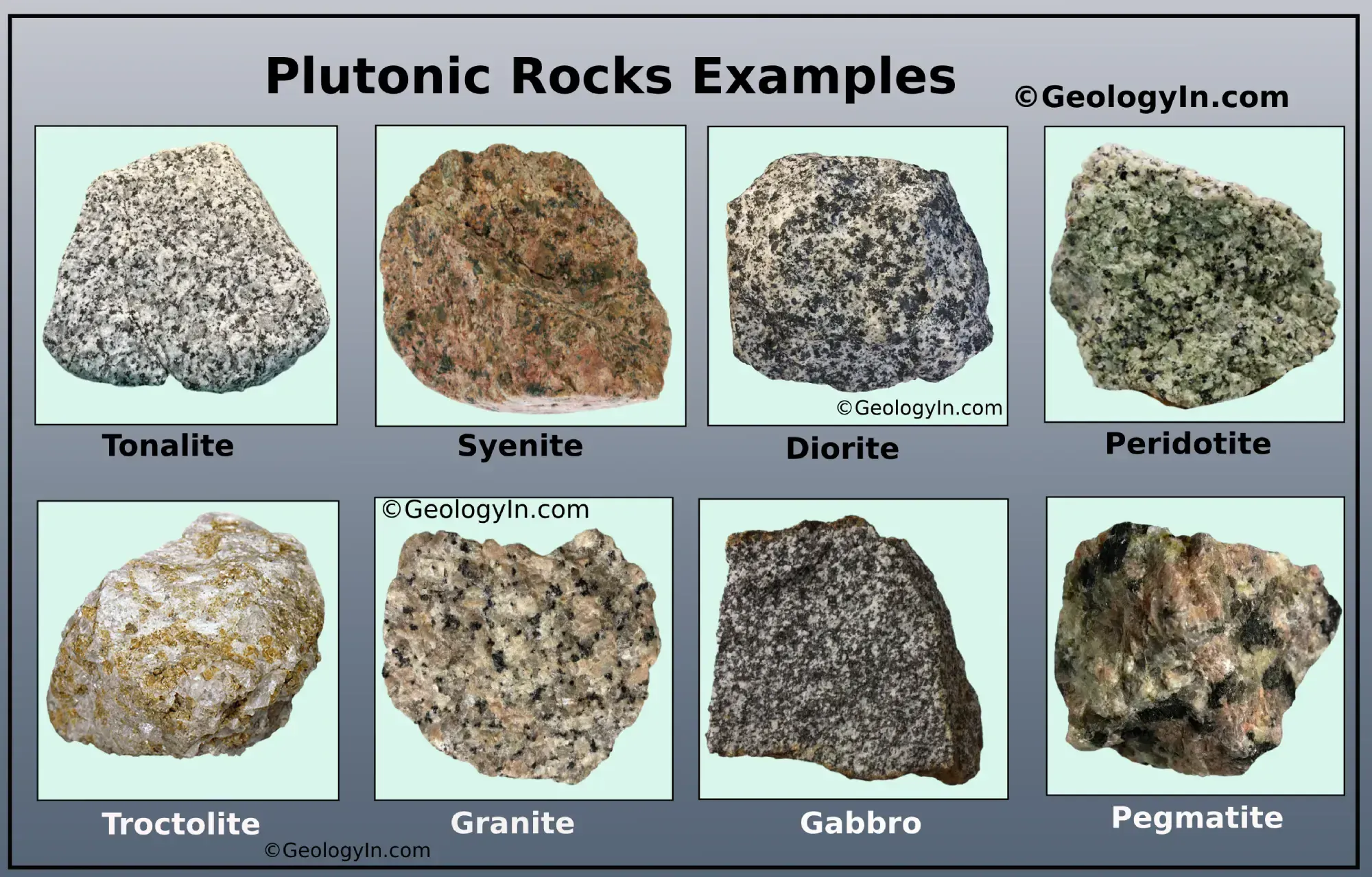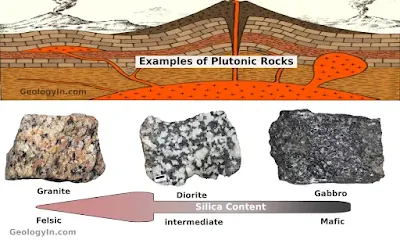Plutonic Rocks: Defination, Characteristics, Examples
Plutonic rocks are igneous rocks that form deep underground when magma cools and solidifies within the Earth's crust. Magma is hot, molten rock that originates deep within the mantle. As it rises through the crust, it can cool and solidify before reaching the surface.
Some common plutonic rocks examples: granite, gabbro, diorite, pegmatite, peridotite, syenite, anorthosite, and diabase.
The slow cooling process allows for the formation of large crystals, giving plutonic rocks a coarse-grained texture. These rocks are the most common rocks on Earth and form the basis of our continents and the roots of our mountain ranges.
Plutonic rocks are named after Pluto, the Roman god of the underworld, as they originate deep within the Earth's crust.
 |
| Plutonic Rocks examples |
Characteristics of Plutonic Rocks
Coarse-grained texture (phaneritic): Plutonic rocks have a coarse-grained texture, characterized by visible mineral crystals that are typically larger than those found in volcanic rocks. This coarse texture results from the slow cooling and solidification of magma beneath the Earth's surface, allowing ample time for mineral crystals to grow.
Mineral composition: Plutonic rocks commonly contain minerals such as quartz, feldspar (including both orthoclase and plagioclase varieties), mica (such as biotite or muscovite), amphibole, and pyroxene. The specific mineral composition varies depending on factors such as the composition of the original magma and the conditions of crystallization.
Intrusive origin: Plutonic rocks form through the cooling and solidification of magma deep beneath the Earth's surface. As such, they are intrusive igneous rocks, contrasting with volcanic rocks, which form from lava that erupts and cools rapidly at the Earth's surface.
Large-scale structures: Plutonic rocks often form large, recognizable structures within the Earth's crust. These structures can range from massive batholiths covering hundreds or thousands of square kilometers to smaller intrusions such as stocks, dikes, and sills.
Holocrystalline: Plutonic rocks are holocrystalline, meaning all the material that once formed the magma has crystallized into minerals. Unlike volcanic rocks that may have cooled quickly and contain glass, plutonic rocks have no glassy matrix.
Influence on surrounding rocks: Plutonic intrusions can have significant effects on the surrounding rock formations. For example, they may cause metamorphism in adjacent rocks due to the heat and pressure generated during the intrusion process. Plutonic rocks can also act as sources of mineral deposits, with economically valuable ores often associated with intrusive igneous activity.
High density: Plutonic rocks are denser than volcanic rocks because the slow cooling allows for the formation of denser minerals.
 |
| Plutonic Rocks |
Examples of plutonic rocks
Granite: Granite is one of the most well-known plutonic rocks. It is coarse-grained and primarily composed of quartz, feldspar (orthoclase and plagioclase), and mica (usually biotite or muscovite). Granite is commonly used in construction, monuments, and countertops due to its durability and aesthetic appeal.
Diorite: Diorite is an intermediate-colored plutonic rock, falling between granite (light-colored) and gabbro (dark-colored) in terms of mineral composition. It typically contains quartz, feldspar, and hornblende (a dark-colored amphibole mineral). Diorite is used for various purposes, including construction aggregate, riprap (stones used to protect shorelines from erosion), and monuments.
Gabbro: Gabbro is a coarse-grained, dark-colored plutonic rock composed primarily of calcium-rich plagioclase feldspar and pyroxene. It is the intrusive equivalent of basalt and is commonly found in oceanic crust and certain mountain ranges. Gabbro is a strong and durable rock and is used for crushed stone applications like road construction and railroad ballast.
Tonalite: Tonalite is a light-colored to intermediate-colored plutonic rock composed of quartz, plagioclase feldspar, biotite mica, and hornblende. It is a common rock in mountain ranges and is often associated with granite. Tonalite is a strong and durable rock and is used in some construction applications.
Peridotite: Peridotite is an ultramafic plutonic rock primarily composed of olivine and pyroxene. It is typically found in the Earth's mantle and is the main constituent of the upper mantle.
 |
| Plutonic Rocks: Defination, Characteristics, Examples |
Plutonic Vs. Volcanic Rocks
Both plutonic and volcanic rocks are igneous rocks, which means they are formed from the cooling and solidification of magma or lava. However, the key difference between them lies in where this cooling and solidification take place.
Volcanic Rocks
Formed when magma erupts onto the Earth's surface, where it cools and solidifies as lava.
Lava cools quickly, resulting in fine-grained rocks with crystals too small to be seen with the naked eye. These rocks are called aphanitic.
Common examples of volcanic rocks include basalt, andesite, and rhyolite.
Plutonic Rocks
Formed when magma cools and solidifies underground within the Earth's crust.
Magma cools slowly underground, allowing crystals to grow large enough to be seen with the naked eye. These rocks are called phaneritic.
Common examples of plutonic rocks include granite, diorite, and gabbro.
Conclusion
In summary, plutonic rocks play a crucial role in understanding the geological processes that shape the Earth's crust. Their distinctive characteristics and wide variety of types provide valuable insights into the composition, structure, and history of the planet's subsurface environment. By studying plutonic rocks, geologists can unravel the complex story of Earth's evolution over millions of years.
Read also:
Intrusive Vs. Extrusive Igneous Rocks

%20(1).webp)






